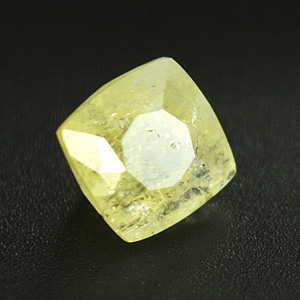Brazilianite
Brazilianite is an extremely rare and stunningly beautiful crystal and is one of the few phosphates to have been made into a precious gemstone. Crystals of Brazilianite were first discovered in 1945 in Minas Gerais in Brazil. Brazilianite of course derives its name from the country Brazil in which it was first discovered.

Brazilianite
(Square cut. From Brazil. 2.00 carat.
7.3 x 7.2 x 6.0mm)
Image © supplied by Freakingcat Gems
Brazilianite Properties:
Brazilianite is a yellow-green phosphate mineral with the chemical formula NaAl3(PO4)2(OH)4 - sodium aluminum phosphate hydroxide. Brazilianite contains 6 percent sodium, 22 percent aluminum, 17 percent phosphorous and 53 percent oxygen.
Crystals of Brazilianite are typically greenish-yellow to olive-green. However colorless and light yellow Brazilianites do occur but are extremely rare. Crystals of Brazilianite are often well formed and well defined: Sometimes perfect crystals of Brazilianite are found up to 12cm by 8cm. The largest crystal of Brazilianite was found in its native Brazil. As the crystals of Brazilianite become larger the clarity of the crystals tend to reduce, hence finding large and clear Brazilianite crystals is difficult, however when small, brazilianite crystals are often of gem quality. [1]
Brazilianite is generally transparent with a vitreous luster which is also noticed on the cleavages of the crystals. Brazilianite crystals display monoclinic prismatic properties. The Brazilianite crystals can also occur in the form of spherical druses (surface made of tiny crystals). Brazilianite might also be euhedral with fibers. Brazilianite crystals do not display properties of twinning.
Brazilianite is known for its relative hardness and Brazilianite at 5.5 Moh is one of the hardest minerals in the phosphates category. However the fracturing on the Brazilianite crystals is quite uneven and irregular thus making the crystals quite brittle. The crystals can be broken with bare hands. The fracturing on the Brazilianite crystals can also be conchoidal in nature. The Brazilianite crystals do not display properties of luminescence and are neither very dense with a density of just 3 g/cm3. Unlike many rare gemstones, Braziliate does not decompose with most acids. However Brazilianite does decompose when it comes into contact with hydrogen fluoride and hot sulphuric acid. However it takes few hours for the Brazilianite crystals to completely decompose when they come into contact with the two compounds.
The crystals of Brazilianite are so rare that it is near to impossible to find crystals larger than just a few centimeters in the natural formations of Brazilianite. Fine examples of uncut brazilianite measuring 5cm in length may fetch several thousand dollars, though less transparent examples may be seen at three figure prices. Brazilianite is sometimes moderately included and hence eye-clear gemstones of Brazilianite are hard to come by.
Brazilianite Occurrence:
The only significant deposit of Brazilianite comes form Conselheiro Pena, Minas Gerais, Brazil. The type locality for Brazilianite is Córrego Frio mine, Linópolis, Divino das Laranjeiras, Doce valley, Minas Gerais, Brazil. Larger crystals of Brazilianite which were found in Brazil have been kept for mineral collections thus making the gemstones of Brazilianite extremely rare - and it is said to be difficult to find crystals larger than just a few centimeters in size. This also determines the high cost of the Brazilianite gemstones.
Brazilianite has also been found in trace amounts in Oxford County of Maine in USA, in Grafton County and Sullivan County, New Hampshire, USA and in Yavapai County in the state of Arizona in USA. The Rapid Creek area in Canada is also known to contain trace amounts of Brazilianite.
Brazilianite occurs in granite pegmatites and has been found in association with muscovite, tourmaline, fluorapatite, quartz, feldspars and albite. [2]

Uncut Brazilianite
From Minas Gerais, Brazil. Overall size 3.5 x 2.5 x 1.5 cm.
Photo by Rob Lavinsky, iRocks.com - lic. under CC-BY-SA-3.0
Back to the Gemstones List home page - over 160 gemstones explored!
Brazilianite - Sources Referenced:
[1] http://en.wikipedia.org/wiki/Brazilianite
[2] http://www.mindat.org/min-760.html
Please feel free to link to this page - copy / paste the text below: (click to select)
Privacy Policy | Cookie Policy | GDPR | About This Site / Terms

© gemstoneslist.com


